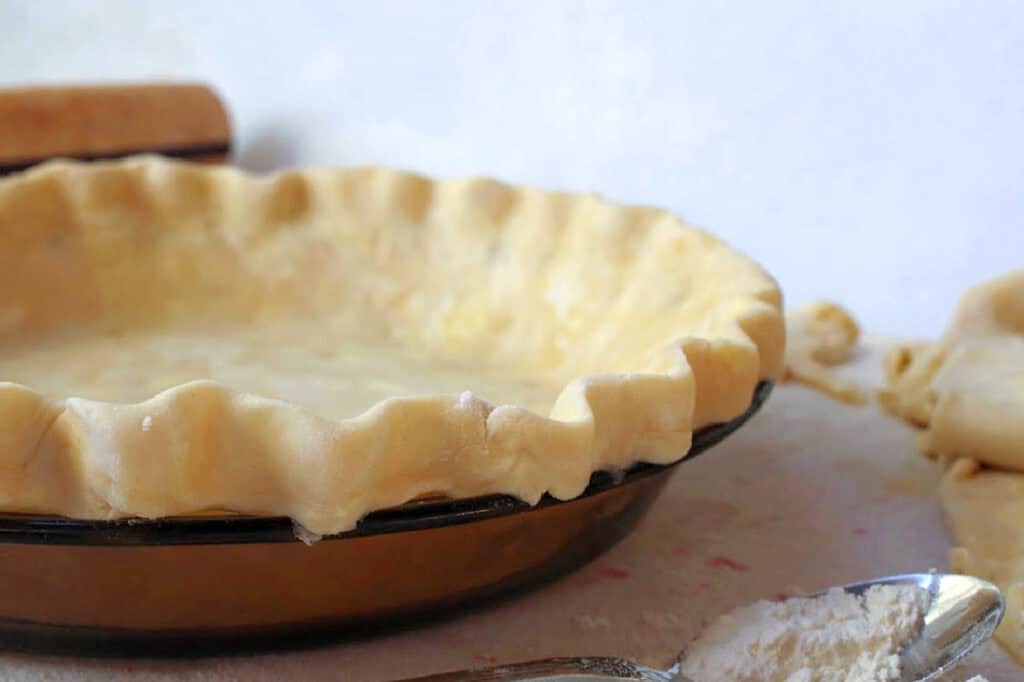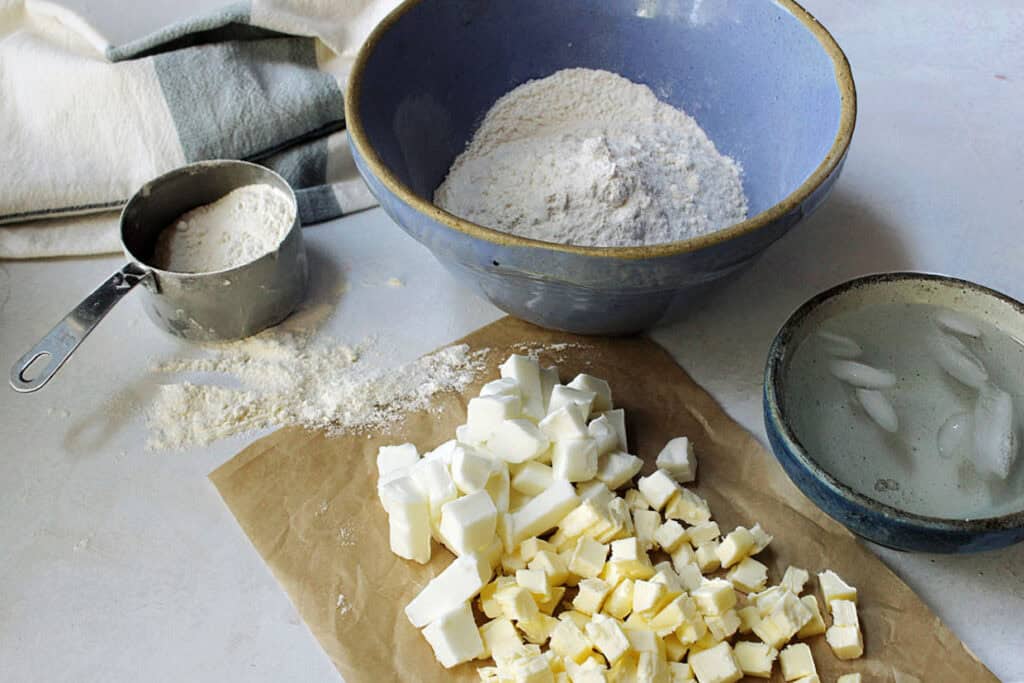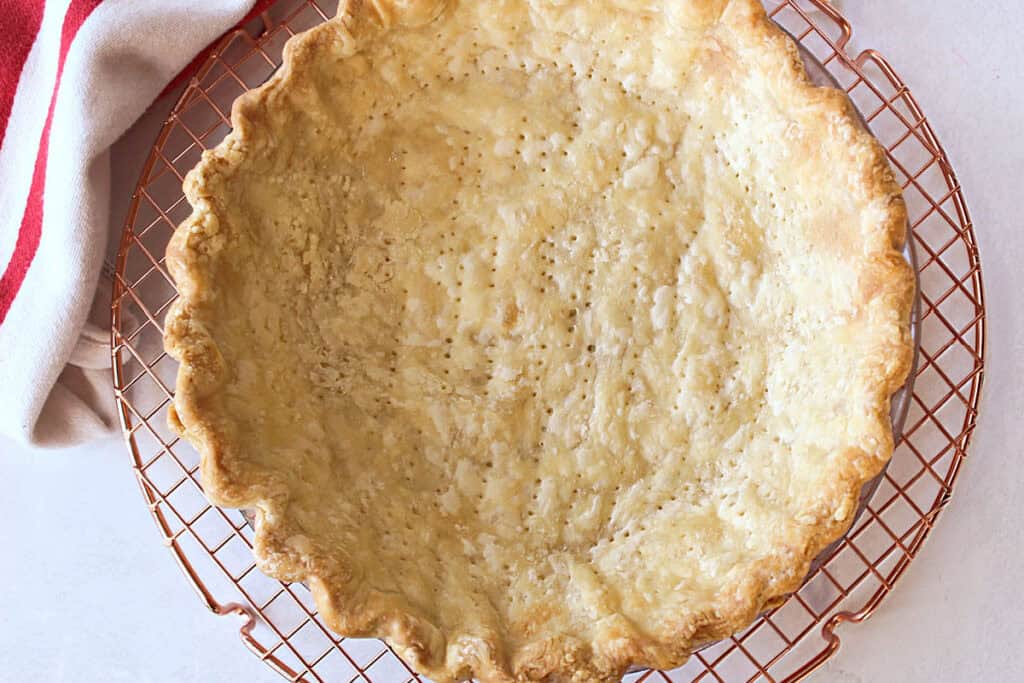The perfect pie crust is flaky, tender, golden brown and with a delicate flavor that complements any paired filling. That combination of texture and flavor starts with the fat. Here are the differences between butter and shortening and how to choose which to use in your next pie.

The pie filling is most often the focus of your pie. But whether it’s a silky custard or tart-sweet fruit filling, the crust should be more than a means to hold everything together. A perfect pastry crust balances out the pie.
Several factors contribute to a great crust. Quality flour and not over-mixing the dough reduces gluten development, keeping the finished crust tender. You can even use keto flour for pie dough.
But fat is the most important component when it comes to flakiness and flavor. Butter, shortening or other fats are essential to a pie crust, yet each has different characteristics. How do you choose which to use in your crust?
The role of fat in pie crust
A pastry crust needs only three ingredients: Flour, fat and a liquid of some sort. Of course, most bakers will add a pinch of salt and there is room to experiment with different flavors and textures. But in the end, these three elements must be present.
Fat is responsible for creating the flakiness of the pastry. When you make a pie crust, you cut in the fat, leaving pea-sized pieces of butter or shortening dispersed throughout the dough. As the dough cooks, the fat melts and releases steam. The steam creates pockets in the baked crust, translating into a flaky, crispy bite.
Butter, shortening or other fat in a pie crust also inhibits gluten development. Gluten turns a pie crust tough and chewy. By coating the flour particles, the fat reduces gluten to keep the crust tender. It also helps bind the crust together and reduce extra moisture that could make it soggy. Finally, the fat can also provide an element of flavor.
Which fat you choose — shortening, butter or lard — will impact the crust’s flavor, texture and even color. Different fats can also be easier or harder to work with and still get the perfect result.
Butter for a flavorful pie crust
Butter is a go-to fat for pie crust. It results in a flavorful crust with a beautiful golden-brown color. The rich flavor pairs especially well with fruit pies where the taste of butter balances out the sweetness of the fruit. For instance, sweet cherry hand pies shine with a butter crust since the crust is a larger portion of each bite.
The challenge with butter is its low melting point. With just a little heat, butter will begin to melt, which can reduce the flakiness of the pie. Keeping everything as chilled as possible when working with butter will help make the pie crisp.
Shortening for a flaky pie crust
The use of shortening as the fat in your pie crust is the secret to a flaky crust. Shortening has a high melting point and will stay solid until it goes into the oven, resulting in an extremely flaky crust nearly every time.
Shortening has less flavor than butter, so crusts made with it can taste bland. This works well for flavorful cream fillings or when adding flavorings, like in a chocolate tart crust. Shortening crusts also don’t turn as golden as butter crusts when baked.
Mixing butter and shortening: The ultimate pie crust hack
Both butter and shortening offer benefits when it comes to pie crust, and a few drawbacks. But the secret to the perfect pie crust is using half butter and half shortening. The butter provides flavor while the shortening creates the layers in the finished crust.
A fifty-fifty butter and shortening pie crust recipe will yield dependable results each time. Highly versatile, this combo makes an ideal base for any pie that needs a pastry crust.

“Using equal parts butter and shortening has been the best change I’ve made for my pie crust! The different fats melt at different temperatures, which helps flaky layers develop as it bakes. When mixing, I lightly toss the dry ingredients with grated butter and shortening pieces to coat the fat in the dry mixture. As you roll out the dough, you should still see small, intact pieces of fat spread throughout, ensuring a flaky, tender crust.”
— Michelle Goth, Blackberry Babe
What about lard for pie crusts?
Although butter and shortening are the most common options for pie crust, lard can also be used as the fat in your pie. Lard, rendered pig fat, is flavorful and ideal for a flaky crust. High-quality lard will set your pie crust apart, so opt for leaf lard if you can find it.
Tips for working with fat in a pie crust
No matter which fat you choose, you want to keep it as cold as possible. If the fat begins to melt before baking, you will not get those ideal pockets of steam, and the crust will not be as flaky.
To help keep things cold, place the measured-out shortening in the freezer for an hour before starting your crust. You can also store the shortening container in the freezer at all times. It won’t freeze solid, so you can still measure what you need when making your crust.
Keep butter in the fridge until you’re ready to use it. You can also store butter in the freezer and grate it into your pie crust with a cheese grater. This keeps the butter solid and also makes it easier to cut in.
When cutting your fat in, smaller chunks will give the finished crust a finer, tender texture. Leaving bigger chunks will create more layers. Play around with different sizes to see which result you prefer.
As you make your pie crust, avoid handling the dough too much, as the heat from your hands can cause the fat to melt. Use cold water, vodka or whatever liquid you are using to bind your pie crust, and set the dough in the fridge or freezer between mixing, shaping and baking to help the fats resolidify.

Get ready to bake the perfect pie
Whether you’re making a pie for a holiday party, Pi-Day or simply your favorite dessert, starting with the right crust is key to a fantastic pie. Get all the flavor with butter, nail a flaky crust with shortening or bake the perfect crust with a mixture of both. With the right pie-making tips, your pie crust can be the best part of your pie.
Jere Cassidy is the writer and recipe developer behind the blog One Hot Oven. A passion for all things food-related led her to culinary school to expand on her baking skills and now to share easy recipes for all home cooks and bakers of all skill levels. When not in the kitchen, Jere’ likes to travel far and wide to find delicious food.